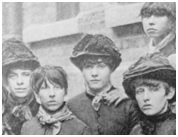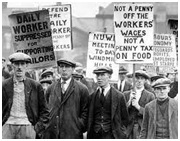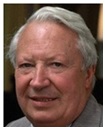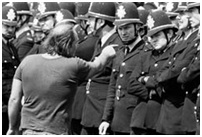|
 |
|
 |
The British Miners’ Strike (1984-5) - Unions and Management
The British miners’ strike (1984-5)
Famous for... A bitter year long strike (5th March 1984 - 3rd March 1985) between:
a) the National Union of Mineworkers (NUM) (the British coal miners’ union)
b) the National Coal Board The miners’ employer - owned by the government because the coal mining industry was nationalized in 1947.
Key people
British prime minister, pictured right.
Arthur Scargill Miners’ union (NUM) leader.
Ian MacGregor Boss of the National Coal Board.
Why did the strike happen?
1. Pit closures The government (led by the prime minister, Margaret
Thatcher) wanted to close loss making coal mines (or pits). But the NUM (led by Arthur Scargill, pictured right during the strike) wanted to keep them open, because mining towns depended on coal for employment. It was the first British miners’ strike in history about jobs not money.
2. Mining is mucky Working underground in a mine is a horrible and dangerous job, although working conditions had improved greatly since 1945. The mining industry had a long history of fatal accidents, mainly caused by
3. Pride in the past The National Union of Mineworkers, and other trade unions, were proud of their history and their past battles with employers over:
The miners had major victories in the 1972 and 1974 strikes during prime minister Edward Heath’s Conservative government (in which Margaret Thatcher served). She was determined not to be humiliated again. Probably the most famous miners’ strike was in 1925 that led to a general strike a year later. The 1925 strike was led by A.J. Cook, pictured right, whose slogan was: “Not a penny off the pay, not a minute on the day”.
Key events in British trade union history
1834 The Tolpuddle Martyrs A group of farm labourers (from Tolpuddle, Dorset in southern England) were convicted and transported to Australia for joining a trade union. They were found guilty under an old law that prohibited the swearing of oaths (even though unions had been made legal in 1824). After a huge public outcry, they were:
1888 Bryant and May strike A successful strike by the women at the Bryant and May match factory in London (pictured right) who were fighting for better pay and working conditions.
1901 The Taff Vale Case This court case decides that a union can be sued for profits lost during a strike. The decision is reversed by the 1906 Trade Disputes Act.
1926 General Strike (in which all trade unions strike in support of the miners, whose strike, pictured right, had started in 1925, but it collapses in six days).
1945-79 Powerful unions Trade unions co-operate closely with governments over pay and economic policy, particularly in the Labour government 1974-9. But they oppose pay restraint in:
a) the successful miners’ strikes (1972 and 1974) The 1974 strike led to the defeat of Edward Heath’s government.
b) the Winter of Discontent (1979) This led to the:
1979-90 Margaret Thatcher’s attack on unions Margaret Thatcher’s three Conservative governments:
Key events in the strike
5 March, 1984 Closure of the Cortonwood pit in Yorkshire is announced. Yorkshire miners start the strike.
6 March, 1984 Closure of 20 pits announced with the loss of 20,000 miners’ jobs.
18 June, 1984 The Battle of Orgreave - thousands of police ensure that coke supplies get through to a steel works at Orgreave in South Yorkshire 10,000 striking miners (pickets including the miners' leader, Arthur Scargill) unsuccessfully try to stop them.
11 December 1984 Nottinghamshire miners:
3 March 1985 The NUM ends the strike.
Why did the miners lose?
She was:
These strikes occurred under the previous Conservative prime minister, Edward Heath (pictured right). She carefully planned for the strike in various ways:
a) electricity Coal stocks were stockpiled at power stations (then mostly coal fired), so that the country would not quickly run out of electricity. Thatcher also invested in other forms of power generation like oil, gas and nuclear.
b) police protection Thatcher made sure there were enough police to ensure that pickets (striking miners) didn’t stop:
The strike’s biggest battle was at the steel plant at Orgreave in South Yorkshire. c) Ian MacGregor (pictured right) In September 1983 Thatcher appointed this tough Scottish born American as boss of the miners’ employer, the National Coal Board, to:
But MacGregor:
2. Arthur Scargill Scargill became leader of the miners’ union (the NUM) in 1981 and was a brilliant speaker. But he made several big mistakes:
a) delusion Scargill:
b) inflexibility Scargill:
This offer would have been seen as a victory for the miners.
c) divisiveness Scargill failed to:
d) poor public image Scargill's Marxist (strongly pro-worker and anti-capitalist) views:
e) poor planning Scargill started to strike at the end of winter when the demand for coal and electricity was falling.
3. Violence The strikers had violent clashes with thousands of police (pictured right) which lost them public support (although the strong arm tactics of the police were also criticized). Some strikers threatened or intimidated:
a) working miners (who were also badly beaten and their families terrorized).
b) some union leaders (who criticized the strike). For example, the union boss, Norman Willis (pictured right), had a hangman’s noose lowered above his head, when he spoke against violence.
Sadly there were deaths:
4. Working miners Most miners in Nottinghamshire, Leicestershire and Derbyshire carried on working. They provided vital coal supplies to power stations. The Nottinghamshire miners even set up a breakaway union, the Union of Democratic Mineworkers.
Results of the strike
1. Support for Thatcher Margaret Thatcher’s victory:
But many people were concerned about the:
2. Scorn for Scargill Scargill was unpopular (even among some miners and trade unionists) because of his:
After the strike he was never as powerful again and resigned as the NUM leader in 2002.
3. Collapse of the coal industry One thing that Scargill did get right was the government’s destruction of the coal mining industry. In 1985 alone, 25 pits were shut down, including Cortonwood, the Yorkshire mine where the strike began. During the strike there were nearly 250,000 miners, but in March 2011 there were only 6,000. This wasn’t necessarily disastrous for the miners, because mining was such an unpleasant job.
4. New Labour The strike taught the British Labour Party that:
This resulted in:
5. Attack on unions Her victory enabled Margaret Thatcher to launch a big attack on trade union power. Union influence in Britain fell dramatically because of: a) Thatcher's attack. b) the decline in strongly unionized industries (like coal and steel). Between 1980 and 1987 British union membership dropped from
In 2010 this figure had fallen still further to 6.5 million.
6. Increased management power As unions declined, managers could:
7. The triumph of community The miners supported each other selflessly during the financial hardship of the strike, when the strikers weren’t paid. The 1984 Christmas was particularly miserable.
Key quotes
There are no uneconomic pits. - Arthur Scargill, 1984.
The lady’s not for turning,
I am extraordinarily patient, provided I get my own way in the end,
We raise the watch-word liberty. We will, we will, we will be free! - George Loveless, one of the Tolpuddle Martyrs (pictured right) after being convicted for joining a union.
Books about the miners The most famous book, set in a south Welsh mining village, is How Green Is My Valley by Richard Llewellyn. This was made into an Oscar winning film in 1942.
Films about the miners
(see above).
The story of a miner’s son (pictured right) who:
|
|
|
||
|
|
|
||
|
||
| Copyright © wisdomtowin.com All Rights Reserved | ||
|














